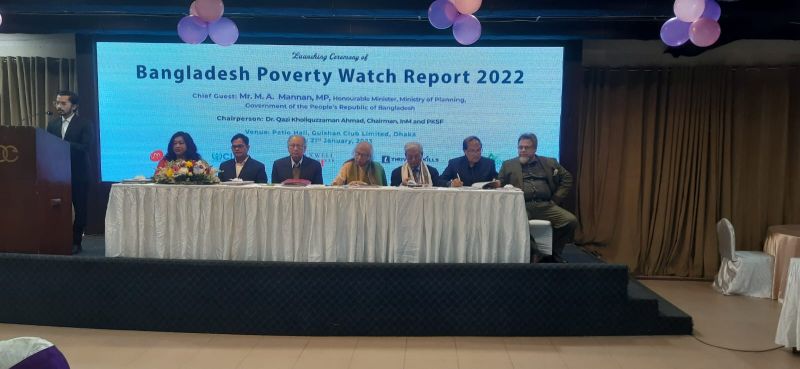- Bangladesh Bank Buys $115 Million to Support Forex Market |
- Tarique Rahman, Daughter Zaima Added to Voter List |
- NCP and LDP Join Jamaat-Led Eight-Party Alliance |
- Tarique Rahman’s gratitude to people for welcoming him on his return |
- Attorney General Md Asaduzzaman resigns to contest election |
Left-behind communities have issues related to local govts

Bangladesh poverty watch report 2022 was launched on Saturday in Dhaka.
Dhaka, Jan 21 - Regular monitoring of progress is important to assess the degree of convergence between the left behind and the relatively advanced population groups and the lagging and the well-off regions of Bangladesh, says the Bangladesh Poverty Watch Report 2022 on Saturday.
The report, jointly prepared by Institute for Inclusive Finance and Development (InM) and Center for Inclusive Development Dialogue (CIDD), aimed to ensure that grassroots voices of ‘left behind’ and extremely poor population groups are heard and these are reflected in policies.
Chairman, CIDD Dr. Mustafa K. Mujeri and Chairman InM Dr. Qazi Kholiquzzaman Ahmad, among others, spoke at the launching event for the Bangladesh Poverty Watch Report 2022.
The Poverty Watch Report 2022 summarised some current aspects of poverty including testimonies, reflections and ‘stories’ of individuals from selected ‘left behind’ population groups belonging to seven plain land ethnic minority groups (Santal, Mal Paharia, Garo, Hajong, Mandi, Oraon and Munda) and the transgender community.
In their ‘stories’, the participants shared their experience of having found themselves in poverty, exclusion and extremely difficult conditions reinforced by systemic errors and structural inequalities.
The Report suggests several priority actions for speeding up their catching up process in society.
The key will be to craft these policies/actions within the broader inclusive development strategies of the government that cover cross-cutting and national level issues, such as strengthening inclusive growth, ensuring financial inclusion, reducing income and social inequality, accessing quality education, health, nutrition and other basic services, adopting appropriate macroeconomic policy, addressing pockets of lagging social groups/regions, and adopting initiatives at the local level along with effectively managing micro-macro transmissions, according to the report.
These left-behind communities have issues that are directly or indirectly related to the daily work of the local governments and local institutions, said the report.
For implementing the agenda, one important element will be to utilise the potential of local action to drive development and create appropriate legal and financial frameworks to support all local partners in playing their part in the achievement of the integrated and universal inclusion agenda.
The key is to empower all local stakeholders, especially the local government institutions, aimed at making sustainable and inclusive development more responsive, and therefore, relevant to local needs and aspirations.
The goals will be reached only if local actors including these left-behind communities fully participate, not only in the implementation, but also in the agenda-setting and monitoring processes.
Participation requires that all relevant actors are involved in the decision-making process, through consultative and participative mechanisms, at the local and national levels within the overall inclusion framework, according to the report. - UNB

